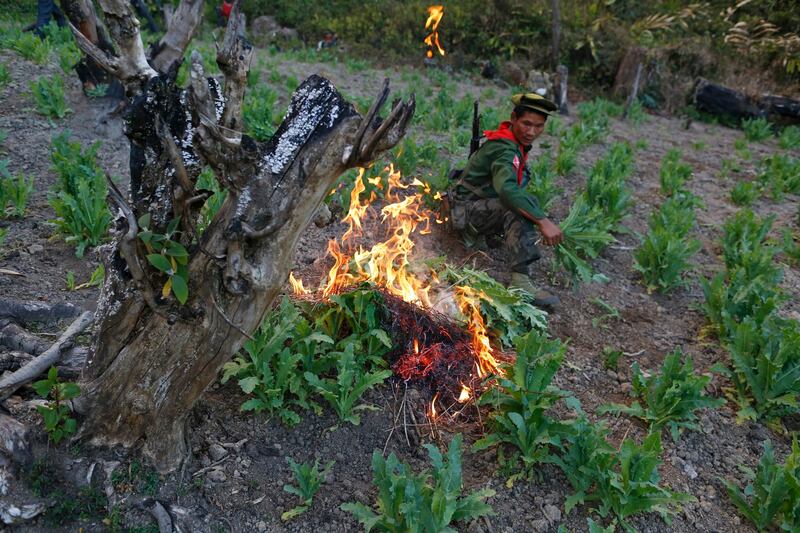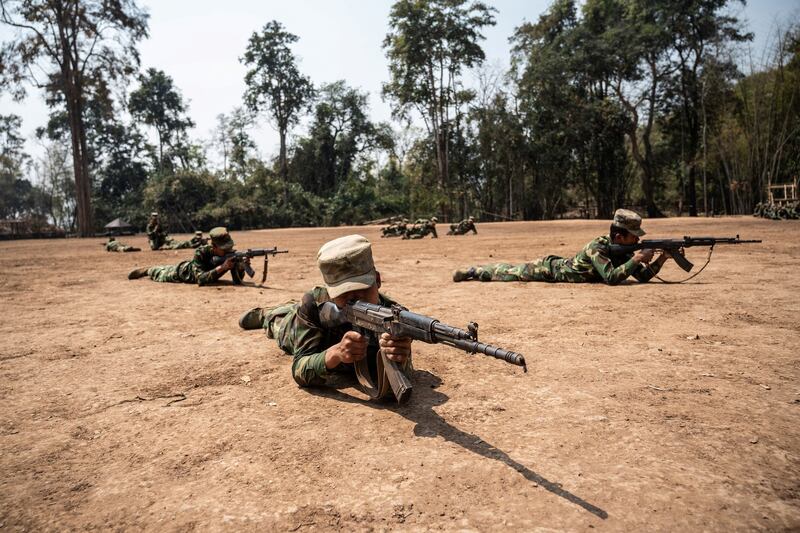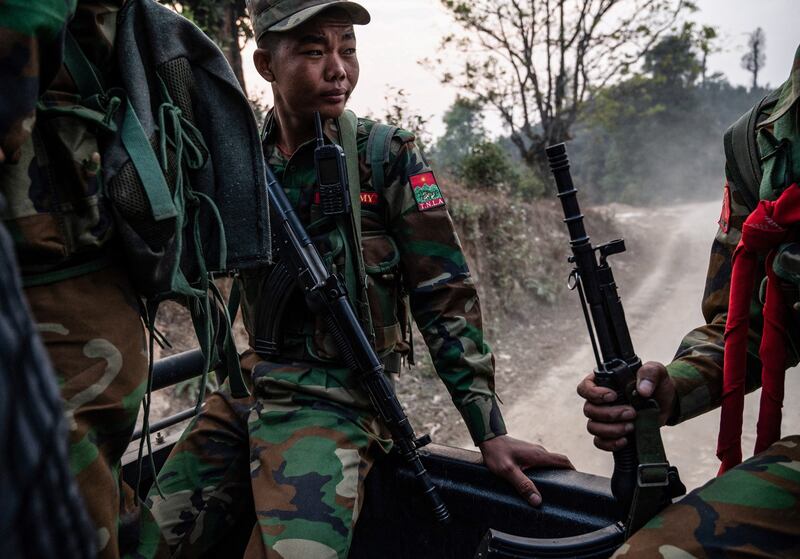In Myanmar’s complex battle space, Shan state is a particularly fluid patchwork of people’s defense forces, ethnic resistance organizations, and criminal gangs, all with varying loyalty to the military junta or the opposition National Unity Government.
The Shan-based Brotherhood Alliance is made of three ethnic armies that are publicly supportive of the goal of the National Unity Government (NUG) of establishing a federal democracy. They provide tacit support and training for opposition People’s Defense Force (PDF) militias, but they fight mostly in self-defense.
The Brotherhood Alliance includes the Arakan Army (AA), the Ta'ang National Liberation Army (TNLA), and the Myanmar National Democratic Alliance Army (MNDAA), also known as the Kokang army. Shan state shares borders with key regional players China and Thailand.
The Arakan Army, the largest of three, gets most of the attention in its fight for a homeland in Rakhine state in Myanmar's far west. When fighting briefly resumed in late-2022, it was seen as a front that could break the 30-month-old military junta's back.
But the TNLA, though a small organization, is an important bellwether of how the war could evolve.
There've been five major clashes between the military junta and the TNLA since December. RFA reporting has described almost daily encounters in the past two months.

The TNLA is the armed wing of the Palaung State Liberation Front, which represents the Ta’ang, an ethnic minority group of half a million people found in Shan state, northern Thailand and China's Yunnan Province.
Early Ta’ang militias picked up arms in 1963, but reached a ceasefire in 1991, and surrendered their arms in 2005. Out of the ashes emerged the TNLA and its political arm, supported by the Kachin Independence Army (KIA).
The military’s 2008 constitution established a small Palaung Special Administered Zone encompassing two townships in northern Shan State, though it was autonomous in name only. The TNLA was not a signatory to the 2015 Nationwide Ceasefire Agreement, but announced a unilateral ceasefire in 2018, though resumed fighting in 2019 when fighting broke out between the government and the Arakan Army in Rakhine state.
Three things make the TNLA distinct.
First, although it only has 7,000-10,000 men under arms, the TNLA is arguably the most cohesive ethnic resistance organization. They are well armed and militarily competent.
Second, they take a clear anti-narcotics position, otherwise unheard of in Shan state, which is the epicenter of regional synthetic drug production. The TNLA runs check points, seizes and publicly incinerates illicit narcotics, destroys opium fields. These actions anger the military, their border guard forces, and pro-junta ethnic armies – all of whom profit from the drug trade.
Third, the TNLA understands that autonomy is contingent on the establishment of a genuine federal system in multiethnic Myanmar, so they are staunch advocates for national political reform.
The Impact of the coup
Following the Feb. 1, 2021 coup d'etat, the TNLA suspended their ceasefire and voiced support for the NUG, but they did not formally ally with the main opposition. In March 2021, the Brotherhood Alliance threatened the junta that they would join the NUG if the military did not cease their attacks on the three members.
The TNLA has been giving tacit support to the NUG in four ways.
First, it expelled the pro-junta Shan State Restoration Council from northern Shan State by late 2021.
Second, it banned the sale of products from military-owned companies – including Myanmar Beer, Red Ruby and Premium Gold Cigarettes – within its territory.
Third, the TNLA welcomed Burmese opposition figures into its territory, and once the NUG announced its “People’s War” in September 2022, began training and equipping local PDF militias.
Fourth, in January, TNLA Chairman Lieutenant-General Tar Aik Bong rejected the military’s attempt to hold elections as a political off-ramp.
"Our revolutionary forces have an opportunity to prevent this election. Only by using this opportunity can we free future generations from the enslavement of the military,” he declared.
Clashes with military government forces erupted in January 2022, but died down.
In December 2022, however, the military increased operations in Shan state to control major roads, leading to clashes with the TNLA and a sustained aerial campaign. There were some 30 air strikes in a single week after TNLA forces surrounded several military units. The military, unconvincingly, chalked this up to a “misunderstanding”.

Violence has escalated in 2023.
After several snubbed invitations from the junta, on June 1, the Brotherhood Alliance met with a junta delegation, at the prodding of China.
After hedging its bets, China has doubled down on its support of the junta, and has been actively pressing the Northern Alliance to stop their active support for the NUG and cease all offensive operations.
The talks quickly broke down, and the Brotherhood Alliance rejected the junta’s calls to support proposed “elections.”
Fighting between the military and the TNLA intensified in July as the junta tried to retake the road outside of Muse, an important border crossing with China, where the TNLA has been inspecting vehicles for illicit narcotics.
Worth watching
While the junta controls the China border city Muse, it has tenuous control of the surrounding countryside. The military regime has artillery positions in Muse, which they use to target TNLA positions, though more often killing innocent civilians.
Clashes continued through August. Notably in one ambush of an army supply convoy NUG PDFs were fighting alongside the TNLA. The military has retaliated with air attacks.
The online newspaper Irrawaddy quoted a TNLA officer as saying that it had more than a dozen clashes with the junta in August, with tensions remaining high in two northern Shan townships.
"There were 13 clashes in August and all because of massive advances by the military into our territory,” Lieutenant Colonel Tar Aik Kyaw from the TNLA told the independent daily.
So why does the TNLA matter?
First, should the violence escalate, the TNLA could publicly embrace the NUG and begin coordinated offensive operations. At this point, the military junta fights the TNLA at its choosing, but that could change.

If the NUG continues to make gains this year, the Brotherhood Alliance could bandwagon in order to secure a better negotiating position for itself over the establishment of a federal system.
Second, the junta has been steadily losing control over its border regions. This was most evident with the recent defection of its Border Guard Forces in Kayah state. In addition to the TNLA, the KIA has stepped up their attempts to control the Lashio-Muse Highway. The regime's forces in the border are isolated and dependent on overland trucks or helicopters for resupply.
The regime is increasingly isolated by international sanctions and even more dependent on non-dollar-denominated trade with China.
Third, while the Northern Alliance may have shrugged off Chinese pressure to reach a ceasefire with the junta, the TNLA is also an important bellwether for how the EROs think about their relationship with the governments in Beijing and the Yunnan capital Kunming.
In January, the Brotherhood Alliance issued a statement in which they pledged to protect Chinese investments - including their trade zone in Muse. This was reiterated in July.
Likewise, the TNLA pledged to cooperate in the combatting of human trafficking and other “illegal activities”, as China takes the threat of transnational criminal enterprises operating out of Myanmar more seriously.
Zachary Abuza is a professor at the National War College in Washington and an adjunct at Georgetown University. The views expressed here are his own and do not reflect the position of the U.S. Department of Defense, the National War College, Georgetown University or Radio Free Asia.
